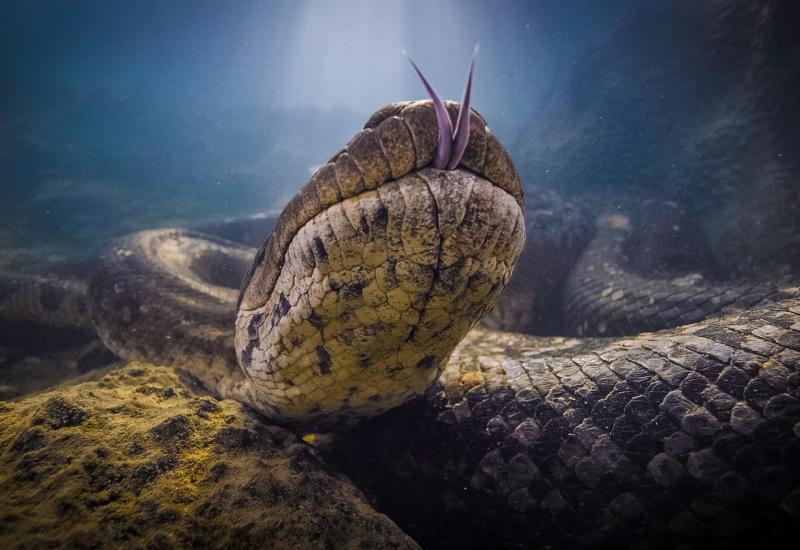Everything (And More) You've Wanted to Know About the Siphonophore

Patrick WebsterA siphonophore, then, is the city itself, while the zooids are the discrete buildings, each with their own special purposes for the larger community.
Quick, what’s the longest animal ever? A blue whale? Some kind of dinosaur? Nope, it’s the giant siphonophore Praya dubia, all 140-plus feet of it—most of us barely dive as deep as it is long! The word siphonophore strikes fear into the hearts of plankton, exposed skin and vocabulary-phobes the world over, but it describes one of the most successful groups of predators on this ocean planet. Species like Nanomia bijuga are at times the most abundant animals in the water column, a stinging gauntlet that plankton must pass through on their daily commute to and from the productive surface waters. So abundant are siphonophores that many species of squid and fish larvae have adaptively decorated themselves in ornate siphonophore-inspired body art to hide among the noxious clouds.
At first glance, a siphonophore will appear much like the more familiar jellyfishes. But, while related to anemones, jellyfishes and corals, siphonophores are in fact colonies of collaborating, individual animals called “zooids” that are all connected by a shared gut.
Imagine a coral colony, with all of its individual polyps, all those teeny-tiny collaborative organisms that work together to build up the larger structure. Now imagine that instead of creating hard reefs like corals do, this colony of individual beings opted to remain squishy, existing like a floating metropolis. A siphonophore, then, is the city itself, while the zooids are the discrete buildings, each with their own special purposes for the larger community. And goodness does it take a village to make siphonophore cities run! What our organs and individual cells do for us, zooids do for the colony—imagine that you didn’t have a liver and instead it was just someone—let’s call them Lee Vurh Logan—there, taking care of business.

Patrick WebsterSiphonophores can look drastically different, such as this giant siphonophore and the hula skirt siphonophore on the right, both found in Monterey, California.
Some zooids exist as jellyfish-like pulsing bells for swimming, while others specialize in commercial fishing and processing, and still more have dedicated themselves to being as sexy as possible to create more siphonophore babies. The colony has a repeating pattern of these specialized zooids (a “cormidium”) that is species-specific—some will have both a float and swimming bells, others just the bells, and still others just the float.
While black-water divers are perhaps the most likely to see siphonophores in action— because siphonophores tend to rise at night to feed nearer the surface—the majority of nearly 200 described species live in the water column as gelatinous fishing nets. But the most famous siphonophore is a sailor: The Portuguese man o’ war—a menace to any nonitchy beach day—got some evolutionary wind in its sails and never looked back from its brilliant blue, buoyant gas float. But siphonophores are comfortable in the extremes! Far more obscure, explorers of deeper Indo-Pacific reefs may come across the bizarre benthic siphonophore, looking much like a circus tent pitched above the benthos.
We historically underappreciated the role of gelatinous animals in the ocean because our nets turned them to goo. It’s only been recently, with underwater robots and scuba-based exploration, that we’ve come to appreciate how ewwy-gooey our world is. And rulers of the booger beings are the siphonophores, the most superlative predators we’ve never heard of. Imagine if we went through our lives ignorant of the existence of eagles, bears and lions, without any knowledge of the words wing, claw or mane to describe their most impressive features. It’s probably too much to assume that words like necto some, tentilla or palpon could ever break through to the world at large. But perhaps just the one word, siphonophore, is enough to share with our friends and family back on shore, to show them just how deep the rabbit hole of life can go when you dive a little deeper into Inner Space.
By The Numbers
Siphonophores live in the open ocean and make up a large portion of gelatinous marine creatures, but most divers have never heard of them before.
175
The number of species of siphonophores that have been described. Who knows how many more are waiting to be discovered! Siphonophores are in the phylum Cnidaria, just like jellyfish and corals.
~150
The longest siphonophore on record was measured at about 150 feet, and was observed by scientists in Australia. The colony was made up of thousands of individual zooids.
1758
The Portuguese man o’ war was the first siphonophore to be discovered, although it is often mistaken for a jellyfish. It was formally described by Swedish botanist Carl Linnaeus in 1758.










